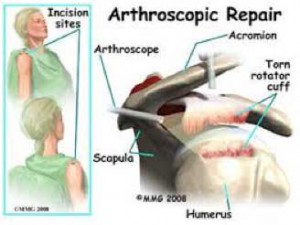Rotator Cuff Repair (Arthroscopic)
 Arthroscopic Rotator Cuff Repair is a minimally invasive procedure to reattach rotator cuff tendon tears. Surgeons operate on the shoulder using small incisions, and use a arthroscope and small instruments. The Rotator Cuff Repair (Arthroscopic) procedure typically leads to a faster recovery time with less inflammation, discomfort and scarring than an open approach. A tear of the rotator cuff is a common injury in which the tendons are pulled off their insertion on the humerus. This often leads to pain and weakness in the shoulder and upper arm requiring surgery to remedy.
Arthroscopic Rotator Cuff Repair is a minimally invasive procedure to reattach rotator cuff tendon tears. Surgeons operate on the shoulder using small incisions, and use a arthroscope and small instruments. The Rotator Cuff Repair (Arthroscopic) procedure typically leads to a faster recovery time with less inflammation, discomfort and scarring than an open approach. A tear of the rotator cuff is a common injury in which the tendons are pulled off their insertion on the humerus. This often leads to pain and weakness in the shoulder and upper arm requiring surgery to remedy.
Preparation for Rotator Cuff Repair (Arthroscopic)
Tell your health care provider what medicines you are taking. This includes medicines, supplements, or herbs you bought without a prescription. Pre surgical preparations for Rotator Cuff Repair (Arthroscopic) may include: Physical examination to include assessment of the AC joint tenderness and or pain with shoulder adduction. Obtain radiographs. Consider magnetic resonance imaging to evaluate the characteristics of the tear.
During the 2 weeks before the surgery:
You may be asked to stop taking medications that make it harder for your blood to clot. These include aspirin, ibuprofen (Advil, Motrin), naproxen (Naprosyn, Aleve), and other medications. Ask your heath care provider which medicines you should still take on the day of your surgery.
On the day of surgery:
- You will likely be asked not to eat or drink anything for 6 to 12 hours before the procedure.
- Take medications your surgeon told you to take with a small sip of water.
- Your surgeon or nurse will tell you when to arrive at the hospital. Be sure to be on time.
Rotator Cuff Repair (Arthroscopic) Surgery
During Rotator Cuff Repair Arthroscopy, your surgeon inserts a small camera, called an arthroscope, into your shoulder joint. The camera displays pictures on a television screen, and your surgeon uses these images to guide miniature surgical instruments.
Because the arthroscope and surgical instruments are thin, your surgeon can use very small incisions (cuts), rather than the larger incision needed for standard, open surgery. All Arthroscopic Rotator Cuff Repairs are usually an outpatient procedure and is the least invasive method to repair a torn rotator cuff.
After the Rotator Cuff Repair (Arthroscopic) Surgical Procedure
In most cases, you will be able to return home on the day of the Rotator Cuff Repair (Arthroscopic) procedure. You will need a companion to drive you home, particularly if general anesthesia has been used.
- Incision care. The portal incisions are so small that they are not always closed with sutures. This will depend on the preference of the surgeon. Dressings are usually light and are kept on for a couple of days. Dressings and wounds should be kept clean and dry. Often, some drainage occurs from the wounds during the first day. This drainage is from the fluid used during the surgery. It is usually light and stops within the first 24 hours.
Complications following arthroscopy are rare. Contact the doctor if:
- Drainage continues from the wound for more than 24 hours after surgery
- Redness or foul odor develops around the wounds
- Pain cannot be controlled by medication
- Your temperature rises above 101°F
- Prolonged nausea and vomiting may be a sign of adverse reaction to pain medication. The doctor should be contacted in this case.
